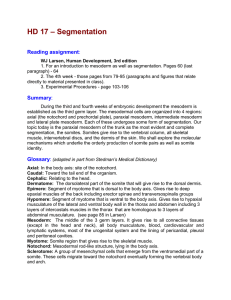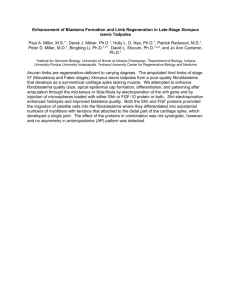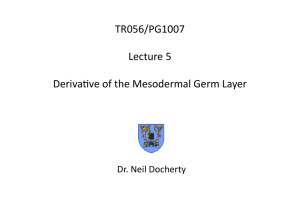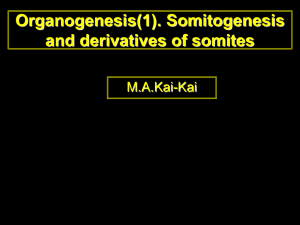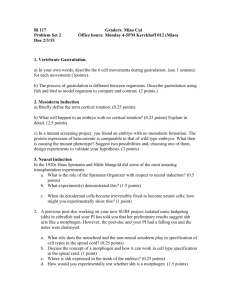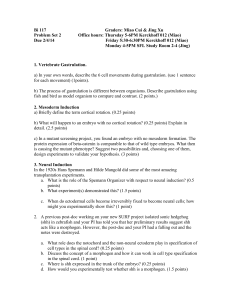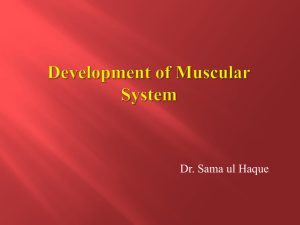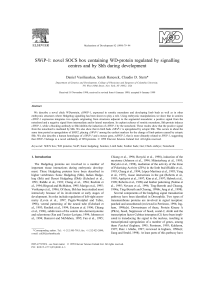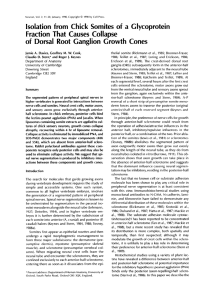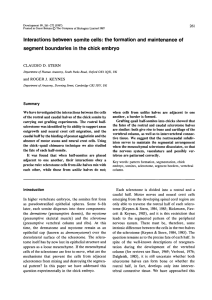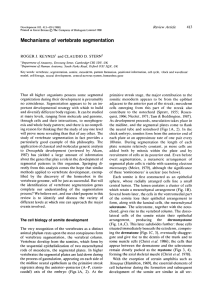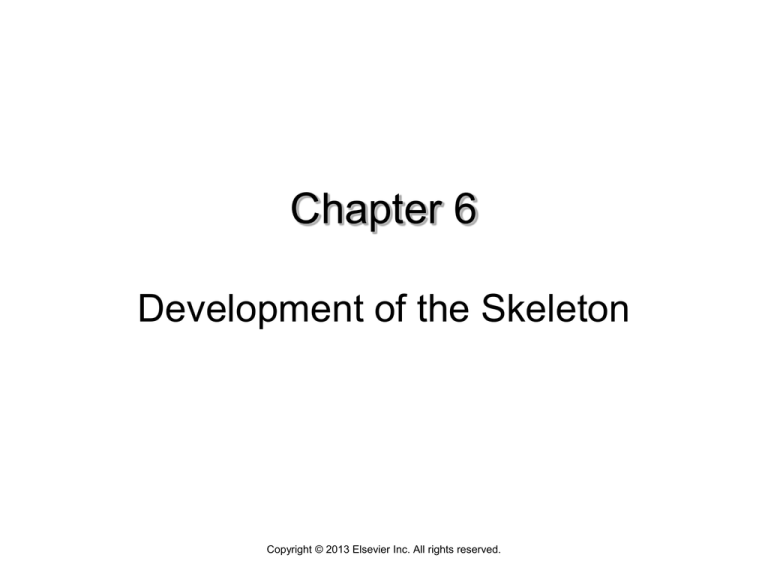
Chapter 6
Development of the Skeleton
Copyright © 2013 Elsevier Inc. All rights reserved.
FIGURE 6.1 Overview of the early chicken embryo, the different mesoderms and their derivatives. Photographs
and corresponding schematic representation of dorsal view (A) and a view of a transverse section (B) are shown.
The PM corresponds to the tissue immediately adjacent to the neural tube and to the notochord. It gives rise to
the axial skeleton and some bones of the skull (neural crest cells, which do not have a mesodermal but an
ectodermal origin, contribute largely to the craniofacial skeleton). The PM undergoes segmentation of presomitic
mesoderm that forms somites thereafter. Somites further mature into sclerotome, which is at the origin of the
axial skeleton. The lateral plate mesoderm (LPM) corresponds to the mesoderm present furthest radially on each
side of the neural tube. It gives rise to the appendicular skeleton. The intermediate mesoderm (IM) is located
inbetween the paraxial and the LPM. It gives rise to internal organs such as the kidneys and gonads. Source: the
scanning electron microscopy image in panel B is reprinted with permission from Monsoro-Burq (2005) [2].
Copyright © 2013 Elsevier Inc. All rights reserved.
2
FIGURE 6.2 Schematic representation of somite formation. Somites form by segmentation of the presomitic
mesoderm at a regular pace (every 90 minutes in the chick and every 120 minutes in the mouse) in a rostral-tocaudal sequence. This process relies on two distinct processes: the generation of a determination front (diagonal
line) that moves posteriorly, and the action of an oscillating biological clock that determines the temporal
periodicity of the somite formation. Activation of the Notch and Wnt signaling pathway oscillates (c-hairy 1
messenger ribonucleic acid (mRNA) expression downstream of Notch signaling is represented as an example).
This insures the temporal periodicity of induction of patterning genes that are responsible for the segmentation.
The determination front is generated by two antagonizing gradients of morphogens along the anterior–posterior
axis: FGF and Wnt have a higher expression caudally and oppose a gradient of retinoid acid (RA) more highly
expressed rostrally. The presomitic cells are thought to be generated by a domain of self-renewing stem cells
(tail bud), which become incorporated into a somite, the 12th and last somite formed in chicken embryo. Source:
adapted from McGlinn et al (2009) with permission.
Copyright © 2013 Elsevier Inc. All rights reserved.
3
FIGURE 6.3 Compartmentalization of the somite into sclerotome and dermomyotome. Transversal section (A)
and schematic representation (B) illustrating the compartmented somite. The ventral portion of the epithelial
somite generates the sclerotome, whereas the dorsal part remains epithelial and becomes the dermomyotome,
which gives rise to dermis and muscle. The myotome (brown-staining product depicting desmin
immunoreactivity) forms between dermomyotome and sclerotome. The sclerotome undergoes differentiation
upon exposure of positive and negative signals released from the surrounding tissues (B). Sonic Hedgehog
(Shh) secreted by the notochord (NO) and the floor plate of the neural tube is a critical positive inducer of the
sclerotome and its differentiation into cartilaginous tissue. Conversely, Wnt signals from the ectoderm and the
roof plate of the neural tube promote dermomyotome formation and inhibit chondrogenesis. Bone morphogenetic
protein (BMP) signals from the lateral plate mesoderm and the roof plate of the neural tube antagonize Shh
signals early during sclerotome formation, but cooperate later with Shh to promote chondrogenesis. Pax1 is a
marker for the early sclerotome, whereas Pax3 expression is restricted to the prospective dermomyotome.
Source: panel A is a reprinted from Kalcheim and Ben-Yair (2005) with permission [273].
Copyright © 2013 Elsevier Inc. All rights reserved.
4
FIGURE 6.4 Schematic representation of early limb formation. Dorsal view (A) of the limb primordium (limb bud),
which is composed of mesenchymal cells encased in an ectodermal jacket and contains specific regions that
pattern the bud along the anterior–posterior (AP), dorsal–ventral (DV), and proximal–distal (PD) axes. The ZPA
(zone of polarizing activity) patterns the AP axis, and the AER(apical ectodermal ridge) maintains outgrowth of
the limb bud, keeping underlying mesenchymal cells in the PZ (progress zone) in an undifferentiated state. The
dorsal and ventral ectoderms determine the DV polarity of the distal part of the limb (not shown). In fish and
amphibians, the region corresponding to the AERis broader and is called apical epidermal cap. The AERis
characterized by the expression of several specific genes (B), among which FGFs (and in particular FGF4) play
a critical role for limb growth and its PD pattering. The polarizing activity of the ZPA is mediated by Sonic
Hedgehog (Shh), which is required to maintain the AERintegrity (B). Shh acts indirectly through the induction of
the expression of a BMP inhibitor, gremlin. Because BMP present in the limb mesoderm suppresses FGF4
expression in the AER, the net action of Shh is to stimulate the production of the FGFs in the AERand thus
maintain AERfunction. FGF4 and other FGFs signal back to the limb bud mesenchyme to maintain the
expression of Shh, forming a positive feedback loop. Source: figure adapted from Capdevila and Izpisua
Belmonte (2001) with permission [274].
Copyright © 2013 Elsevier Inc. All rights reserved.
5
FIGURE 6.5 Endochondral bone formation. A. Mesenchymal cells condense. B. Cells of condensations become
chondrocytes (c). C. Chondrocytes at the center of condensation stop proliferating and become hypertrophic (h).
D. Perichondrial cells adjacent to hypertrophic chondrocytes become osteoblasts, forming bone collar (bc).
Hypertrophic chondrocytes direct formation of mineralized matrix, attract blood vessels, and undergo apoptosis.
E. Osteoblasts of primary spongiosa accompany vascular invasion forming primary spongiosa (ps). F.
Chondrocytes continue to proliferate, lengthening bone. Osteoblasts of primary spongiosa are precursors of
eventual trabecular bone; osteoblasts of bone collar become cortical bone. G. At end of bone, secondary
ossification center (soc) forms through cycle of chondrocyte hypertrophy, vascular invasion, and osteoblast
activity. Growth plate below secondary center of ossification forms orderly columns of proliferating chondrocytes
(col). Hematopoietic marrow (hm) expands in marrow space along with stromal cells.
Copyright © 2013 Elsevier Inc. All rights reserved.
6
FIGURE 6.6 Cooperation of M-CSF, RANKL, and immunoreceptor tyrosine-based activation motif (ITAM) signals
in osteoclastogenesis. Source: figure reproduced from Asagiri and Takayanagi (2007) with permission [275].
Copyright © 2013 Elsevier Inc. All rights reserved.
7
FIGURE 6.7 Coronal suture at P1 in the mouse. This suture occurs at the border of the parietal (p) and frontal (f)
bones. Arrows point to expression of the engrailed 1 gene in osteoprogenitors. Source: reprinted from
Deckelbaum et al. (2006), with permission [276].
Copyright © 2013 Elsevier Inc. All rights reserved.
8


